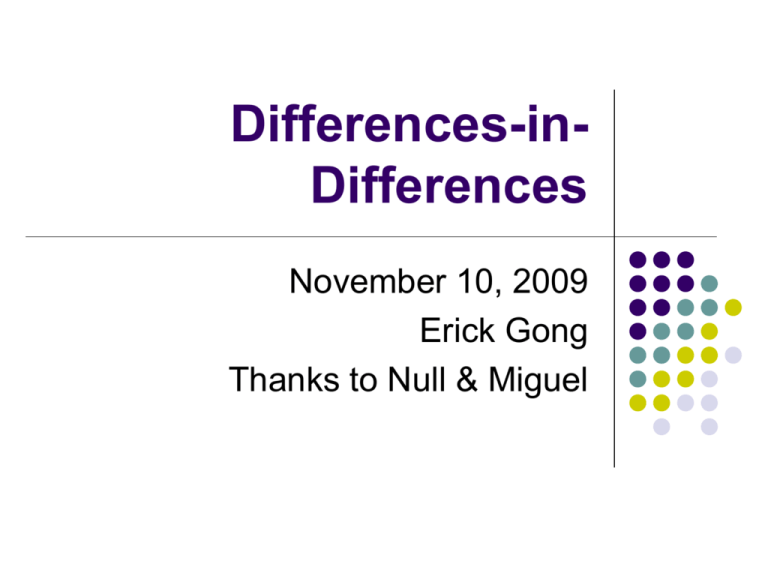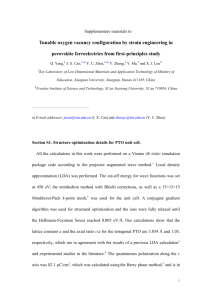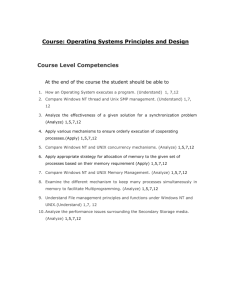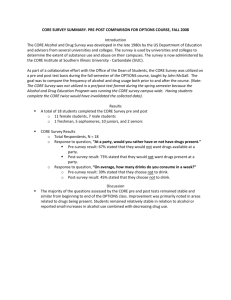Differences-in
advertisement

Differences-inDifferences
November 10, 2009
Erick Gong
Thanks to Null & Miguel
Agenda
Class Scheduling
Diff-in-Diff (Math & Graphs)
Case Study
STATA Help
Class Scheduling
Nov 10: Diff-in-Diff
Nov 17: Power Calculations & Guest Speaker
Nov 24: Class poll: Who will be here?
Dec 1: Review & Presentations
Class Poll: Who will be presenting their
research proposals?
The Big Picture
What is this class really about, anyway?
The Big Picture
What is this class really about, anyway?
Causality
The Big Picture
What is this class really about, anyway?
Causality
What is our biggest problem?
The Big Picture
What is this class really about, anyway?
Causality
What is our biggest problem?
Omitted variable bias
Omitted Variable Bias
The actual cause is unobserved
Happens when people get to choose their own
level of the “treatment” (broadly construed)
e.g. higher wages for educated actually caused by
motivation, not schooling
Selection bias
Non-random program placement
Because of someone else’s choice, “control” isn’t a
good counterfactual for treated
Math Review
(blackboard)
Math Review
for those of you looking at these slides later, here’s what we just wrote down:
(1)
Yi = a + bTi + cXi + ei
(2)
E(Yi | Ti=1) – E(Yi | Ti=0)
= [a + b + cE(Xi | Ti=1) + E(ei | Ti=1)]
– [a + 0 + cE(Xi | Ti=0) + E(ei | Ti=0)]
=b
True effect
+
c [E(Xi | Ti=1) – E(Xi | Ti=0)]
“Omitted variable/selection bias” term
What if we had data from
before the program?
What if we estimated this equation using data from before the program?
(1)
Yi = a + bTi + cXi + ei
Specifically, what would our estimate of b be?
What if we had data from
before the program?
What if we estimated this equation using data from before the program?
(1)
Yi = a + bTi + cXi + ei
(2)
E(Yi0| Ti1=1) – E(Yi0| Ti1=0)
= [a + 0 + cE(Xi0 | Ti1=1) + E(ei0| Ti1=1)]
– [a + 0 + cE(Xi0| Ti1=0) + E(ei0| Ti1=0)]
c [E(Xi | Ti=1) – E(Xi | Ti=0)]
“Omitted variable/selection bias” term
ALL THAT’S LEFT IS THE PROBLEMATIC TERM – HOW
COULD THIS BE HELPFUL TO US?
=
Differences-in-Differences
(just what it sounds like)
Use two periods of data
add second subscript to denote time
= {E(Yi1 | Ti1=1) – E(Yi1 | Ti1=0)}
– {E(Yi0 | Ti1=1) – E(Yi0 | Ti1=0)}
(difference btwn T&C, post)
– (difference btwn T&C, pre)
= b + c [E(Xi1 | Ti1=1) – E(Xi1 | Ti1=0)]
– c [E(Xi0 | Ti1=1) – E(Xi0 | Ti1=0)]
Differences-in-Differences
(just what it sounds like)
Use two periods of data
add second subscript to denote time
= {E(Yi1 | Ti1=1) – E(Yi1 | Ti1=0)}
– {E(Yi0 | Ti1=1) – E(Yi0 | Ti1=0)}
(difference btwn T&C, post)
– (difference btwn T&C, pre)
= b + c [E(Xi1 | Ti1=1) – E(Xi1 | Ti1=0)]
– c [E(Xi0 | Ti1=1) – E(Xi0 | Ti1=0)]
=b
YAY!
Assume differences between X don’t change over time.
Differences-in-Differences,
Graphically
Treatment
Control
Pre
Post
Differences-in-Differences,
Graphically
Effect of program using
only pre- & post- data
from T group (ignoring
general time trend).
Pre
Post
Differences-in-Differences,
Graphically
Effect of program using
only T & C comparison
from post-intervention
(ignoring pre-existing
differences between T &
C groups).
Pre
Post
Differences-in-Differences,
Graphically
Pre
Post
Differences-in-Differences,
Graphically
Effect of program
difference-in-difference
(taking into account preexisting differences
between T & C and
general time trend).
Pre
Post
Identifying Assumption
Whatever happened to the control group over
time is what would have happened to the
treatment group in the absence of the
program.
Effect of program
difference-in-difference
(taking into account preexisting differences
between T & C and
general time trend).
Pre
Post
Graphing Exercise
Form Groups of 3-4
4 Programs
Pre-Post Treatment Effect
Take the difference of post-treatment outcome vs.
pre-treatment outcome
Post-intervention (Treatment vs. Control)
Comparison
Circle what you think is pre-post effect and postintervention treat vs. control effect
Ask group volunteers
Uses of Diff-in-Diff
Simple two-period, two-group comparison
very useful in combination with other methods
Uses of Diff-in-Diff
Simple two-period, two-group comparison
very useful in combination with other methods
Randomization
Regression Discontinuity
Matching (propensity score)
Uses of Diff-in-Diff
Simple two-period, two-group comparison
very useful in combination with other methods
Randomization
Regression Discontinuity
Matching (propensity score)
Can also do much more complicated “cohort”
analysis, comparing many groups over many
time periods
The (Simple) Regression
Yi,t = a + bTreati,t+ cPosti,t + d(Treati,tPosti,t )+ ei,t
Treati,t is a binary indicator (“turns on” from 0 to 1) for
being in the treatment group
Posti,t is a binary indicator for the period after
treatment
and Treati,tPosti,t is the interaction (product)
Interpretation of a, b, c, d is “holding all else constant”
Putting Graph & Regression
Together
Yi,t = a + bTreati,t+ cPosti,t + d(Treati,tPosti,t )+ ei,t
d is the causal effect of treatment
a+b+c+d
a+b
a+c
a
Pre
Post
Putting Graph & Regression
Together
Yi,t = a + bTreati,t+ cPosti,t + d(Treati,tPosti,t )+ ei,t
a+b+c+d
Single Diff 2=
(a+b+c+d)-(a+c) = (b+d)
a+b
Single Diff 1=
(a+b)-(a)=b
a+c
a
Pre
Post
Putting Graph & Regression
Together
Yi,t = a + bTreati,t+ cPosti,t + d(Treati,tPosti,t )+ ei,t
Diff-in-Diff=(Single Diff 2-Single Diff 1)=(b+d)-b=d
a+b+c+d
Single Diff 2 =
(a+b+c+d)-(a+c) = (b+d)
a+b
Single Diff 1=
(a+b)-(a)=b
a+c
a
Pre
Post
Cohort Analysis
When you’ve got richer data, it’s not as easy to draw
the picture or write the equations
cross-section (lots of individuals at one point in time)
time-series (one individual over lots of time)
repeated cross-section (lots of individuals over several times)
panel (lots of individuals, multiple times for each)
Basically, control for each time period and each
“group” (fixed effects) – the coefficient on the
treatment dummy is the effect you’re trying to estimate
DiD Data Requirements
Either repeated cross-section or panel
Treatment can’t happen for everyone at the
same time
If you believe the identifying assumption, then
you can analyze policies ex post
Let’s us tackle really big questions that we’re
unlikely to be able to randomize
Malaria Eradication in the
Americas (Bleakley 2007)
Question: What is the effect of malaria on
economic development?
Data: Malaria Eradication in United States South
(1920’s) Brazil, Colombia, Mexico (1950’s)
Diff-in-Diff: Use birth cohorts (old people vs. young
people) & (regions with lots of malaria vs. little
malaria)
Idea: Young Cohort X Region w/malaria
Result: This group higher income & literacy
What’s the intuition
Areas with high pre-treatment malaria will
most benefit from malaria eradication
Young people living in these areas will benefit
most (older people might have partial
immunity)
Comparison Group: young people living in
low pre-treatment malaria areas (malaria
eradication will have little effect here)
Robustness Checks
If possible, use data on multiple pre-program periods to
show that difference between treated & control is stable
Not necessary for trends to be parallel, just to know
function for each
If possible, use data on multiple post-program periods to
show that unusual difference between treated & control
occurs only concurrent with program
Alternatively, use data on multiple indicators to show that
response to program is only manifest for those we
expect it to be (e.g. the diff-in-diff estimate of the impact
of ITN distribution on diarrhea should be zero)
Intermission
Come back if intro to PS4
STATA tips
Effect of 2ndary School
Construction in Tanzania
Villages
“Treatment Villages” got 2ndary schools
“Control Villages” didn’t
Who benefits from 2ndary schools?
Young People benefit
Older people out of school shouldn’t benefit
Effect: (Young People X Treatment Villages)






